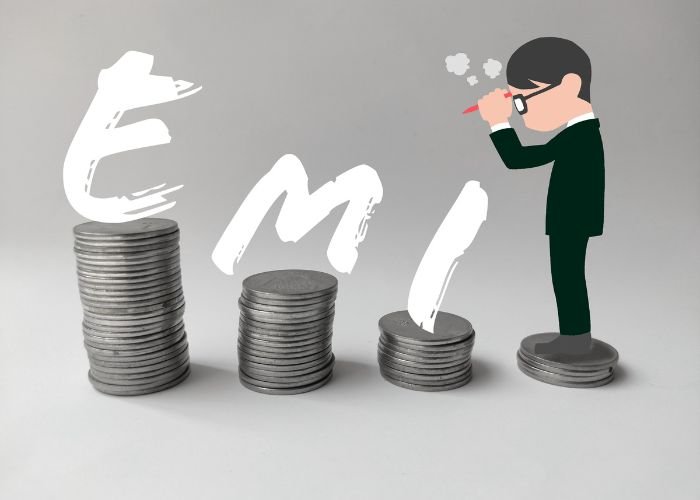It starts quietly. A phone upgrade, a fitness bike, maybe a new mattress. Each purchase feels harmless when the payment is split into small monthly amounts. The offer looks friendly. Zero interest. Just $39.99 a month. But as the payments stack and auto-debits multiply, your income is slowly claimed before it even reaches your account. You are not buying convenience. You are trading control. This is the EMI trap. A silent financial spiral hiding behind easy credit, turning short-term comfort into long-term strain.
What Exactly Is the EMI Trap, and Why Is It Dangerous?
Equated Monthly Installments (EMIs) were once confined to large purchases: cars, homes, education. Today, they’re everywhere. A $1,200 phone is now marketed as “$49.99/month” with 0% interest. Streaming devices, fitness bikes, and even skincare bundles can be paid off monthly. What appears manageable—small fixed payments—accumulates into complex webs of liabilities.
“The EMI trap is not about one large loan. It’s about ten small ones you forget you’re paying,” said a financial behavior expert from a Boston-based think tank.
Psychologists warn of payment numbness: when consumers become desensitized to cumulative outflows due to their fractional nature. A study conducted on 3,000 urban households found that over 58% of participants underestimated their total monthly EMI burden by at least 30%.
That is the EMI trap in action. It’s not the size of each bite, but the number of bites that causes the bleed.
How the Average American Falls Into the EMI Trap Without Noticing
For 27-year-old Cassandra, a graphic designer in Denver, her EMIs looked harmless. A $59 installment for a smartphone, $35 for a tablet upgrade, $42 for a clothing subscription box, and $85 for a gym bike. Nothing alarming.
Until she missed a rent payment.
“I thought I was good with money. I always paid on time. But I didn’t realize I was committing nearly $900 a month to installment-based services,” she said.
Like Cassandra, many Americans are unaware of the psychological shift BNPL (Buy Now, Pay Later) systems have induced. They mimic credit, but without the mental friction typically associated with debt.
In a 2024 survey by a consumer credit advocacy group, 41% of BNPL users said they did not consider their purchases as debt.
That is not ignorance. That is engineered perception.
What Are the Hidden Costs of Living Inside the EMI Economy?
Even at 0% interest, EMIs often come with indirect costs—such as reduced financial agility, higher risk exposure, and poor credit utilization scores.
Here’s how the hidden costs stack up:
- Opportunity Cost: Money tied in fixed EMIs reduces investment flexibility. $400 per month could have gone toward an ETF or emergency fund.
- Late Payment Penalties: Missing one EMI by a day often leads to interest penalties or fees averaging $25 to $40.
- Debt Layering: One installment ends, another begins. There is no debt-free phase. This leads to emotional fatigue and perceived financial stagnation.
- Poor Credit Optimization: While some EMIs do not reflect in credit scores, others impact credit utilization, affecting the ability to qualify for larger loans.
In fact, credit counselors note that individuals trapped in multiple EMIs are less likely to qualify for home loans—even with a decent income—because lenders view fragmented liabilities as red flags.
Can You Spot the EMI Trap Before It Happens?
Avoiding the EMI trap requires more than financial literacy. It requires emotional discipline and environmental awareness.
Watch for these early warning signs:
- You cannot remember how many active EMIs you currently have.
- Your monthly net savings have reduced despite no increase in living expenses.
- You justify each new purchase as “only $XX/month.”
- You feel anxious checking your transaction history.
According to behavioral finance experts, the common pattern is cognitive dissonance: a consumer believes they are “budget-conscious” while consistently overcommitting their disposable income.
“The EMI trap thrives on self-deception,” notes one financial therapist who works with mid-income households in Chicago. “People believe they’re spreading costs. In reality, they’re spreading stress.”
What Happens When Emergency Strikes, and You’re Already Trapped?
For 43-year-old Marcus, a project manager from Charlotte, the pandemic-induced job loss in 2020 was not what destroyed his finances—it was the $1,600 in monthly EMIs he had committed to before the crisis.
With no savings buffer, his credit cards maxed out within three months. “The worst part? Most of those purchases were non-essentials. A home entertainment system. Smart appliances. A premium mattress.”
In 2024, nearly 37% of defaults on personal loans occurred not because of unemployment, but because of EMI overcommitments prior to financial setbacks. The consumer credit lifecycle has become more fragile. Resilience is eroded—not through large debts—but death by a thousand small installments.

How Can You Get Out of the EMI Trap Without Destroying Your Credit?
There is no magic wand. But there is a strategy. It is called debt stacking, and it works.
Step-by-step roadmap:
- List Every Ongoing EMI: Include BNPL, subscriptions, and auto-debits. Knowing the battlefield is half the war.
- Rank by Term and Flexibility: Identify short-term EMIs with penalties for early closure versus flexible ones.
- Kill the Smallest First: Use surplus income to close the smallest EMI, then roll that amount into paying the next.
- Negotiate Consolidation: Call providers and negotiate one larger monthly payment instead of fragmented ones.
- Automate Savings: Build an emergency fund parallel to EMI reduction. One protects your future, the other reclaims your present.
This method, also known as the snowball approach, is shown to increase consumer morale and completion rates. One credit improvement agency found that clients who adopted this model saw a 34% faster debt resolution rate than those who paid randomly.
Related – Stop Paying Only the Minimum Due in Credit Card Every Month
Why Your Lifestyle Needs to Shift—Not Just Your Loan Terms
Getting out of the EMI trap requires more than clearing balances. It demands a shift in consumption logic.
Ask these questions before opting for your next EMI:
- Would I buy this if it required full payment upfront?
- Will this add functional value to my life three years from now?
- Am I masking emotional fatigue with material reward?
Switching from EMI-based consumption to cash-forward behavior rewires financial discipline. Consumers who delay gratification tend to save 28% more annually, according to a study conducted in urban consumer zones in California.
A Seattle couple who had been paying EMIs on furniture, fitness equipment, and high-end appliances transitioned to a strict cash-based model. Within two years, they eliminated all non-mortgage debt and built a six-month emergency buffer.
Their secret? “We learned to say no, even to ourselves.”
What Role Do Platforms and Retailers Play in Feeding the EMI Trap?
The rise of “zero-interest” marketing and embedded finance is no accident. E-commerce platforms actively promote installment schemes at checkout. Credit is no longer something you apply for—it’s something offered as a convenience.
But this convenience has consequences.
Retailers know EMI options increase average cart value by up to 70%. One online electronics store in Texas reported a 62% rise in purchases over $500 after embedding BNPL buttons directly under product pricing.
This is not just fintech innovation. It is behavior manipulation at scale.
Regulatory frameworks are slowly catching up. A federal proposal is underway to mandate transparency in cumulative EMI obligations and simulate the full-debt impact of even 0% loans.
Are You in the EMI Trap Right Now? Here Is How to Check
Use this simple 3-minute test:
- Add all active EMIs. If the total is more than 30% of your net income, you’re in the warning zone.
- List your non-EMI essentials: rent, groceries, utilities. If EMIs exceed these, you’re in the danger zone.
- Check your savings rate. If it’s below 10%, you are losing ground monthly.
The EMI trap often masquerades as lifestyle freedom. But true freedom means being able to say yes or no without checking your repayment schedule first.
Final Thoughts: Escaping the Illusion of Monthly Affordability
The EMI trap is seductive. When wielded responsibly, EMIs can help build credit, manage large purchases, and smooth cash flow. But when they become the default mode of consumption, they erode financial health from within.
As one financial counselor put it: “An EMI is not a budget tool. It’s a future claim on your income.”
Liberation begins when we stop asking “Can I afford the monthly payment?” and start asking “Can I afford the lifestyle cost?”





